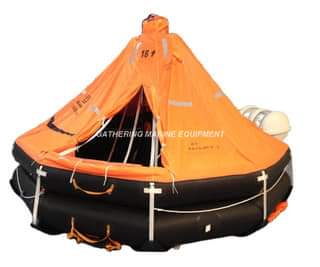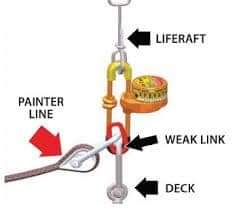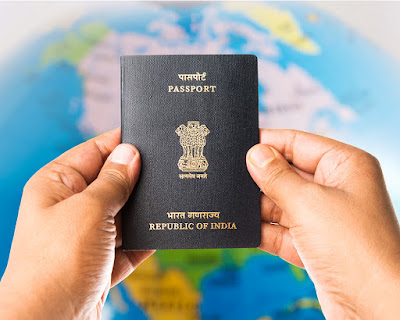Life Raft Release System and Launching Procedure by Capt. Hytham nouni
Life Raft Release System and Launching Procedure
 |
| Life raft |
There are three different method to release liferaft. 👇
1) Auto release with Hydrostatic Release Unit (HRU).
2) Manually launching- throw it into water .
3) Launching by Davit.
Auto Release with Hydrostatic Release Unit (HRU)
The HRU plays an important role when it comes to saving a life during an abandon ship situation. SOLAS 74 clearly specify the requirements for construction and positioning of the HRU at the life raft.
The Working of HRU:
-HRU acts as a connecting media between life raft container and ship deck, where it is stored.
-The HRU comes in action under the pressure of water exerted on HRU when the ship sinks below 4m of water level.
1-The HRU consists of a sharp knife or chisel which is used to cut the strap lashed over the container carrying life raft, but it still holds the painter at the weak link.
2-The HRU is connected to the container through a lashing arrangement which can be disengaged quickly by means of slip hook when launching the raft manually.
3-The HRU is connected to a strong point on deck through a weak link.
4-When vessel sinks, the HRU cuts the rope and the container floats to the surface of water.
5-As vessel sinks further, the tension in the painter causes the life raft to inflate out of the container.
6-The tension acting on the weak link will cause it to break making the life raft free from the ship.
7-When vessel sinks, the HRU cuts the rope and the container floats to the surface of water
Manually Launching
1-Check that one end of the painter of the raft is well secured to a strong point on ship’s deck or structure.
2-Remove the lashing from the container of the raft and open the way to portable rail if available.
3-Check the ship side where the raft to be launched is clear.
4-Two people should lift the container from both sides horizontally and throw the container.
5-Make sure the painter is still fixed at a strong point so that the raft should not be waved away by waters.
6-Pull the painter with a hard jerk to fire the gas bottle to inflate the raft.
7-The life raft will take 20-30 sec to inflate.
8-Board the life raft one by one using ladder or rope.
9-Avoid sharp objects like knives, shoes and other sharp objects etc which may damage the raft surface.
10-When everybody is aboard, after a headcount, cut the painter with a sharp knife.
If the life raft inflates and it is upside down, the raft has a righting strap which is capable of stabilizing it. Climb onto the CO2 cylinder and pull it in the same direction as the wind to do so.
Launching Liferaft by a Davit:
1-Open the lashing and remove the raft container from HRU by opening the manual slip hook or bottle screw arrangement.
2-Tie up the one end of the painter of raft into a strong point at deck.
3-Keep the container in the open and attach the davit hook to the given eye in the canister/ container
4-Take up the raft load by davit and keep the container hanging at embarkation deck area.
5-Pull the painter and inflate the raft. Have a thorough check on the inflated raft.
6-Start boarding the raft without the shoes and other sharp object.
7-After the boarding is completed, check the bottom is clear and release the securing lines, if any.
8-Someone inside the raft will detach the hook of the davit from the raft when tha raft is just above the water.
9-The davit operating person will board the raft either by jumping in to the sea, raft or by other boarding means if provided.
10-Cut the painter and cast away the raft from ship.
Important Requirements for Liferafts and Carrying Capacity
The liferaft of any ship needs to follow the regulations mentioned in SOLAS. Some of the important points regarding liferafts are:
The lift raft should be capable of withstanding exposure for 30 days afloat in all sea conditions.
When dropped into the water from a height of 18 metres, the life raft and all equipment in it will operate satisfactorily.
The floating life raft should be capable of withstanding repeated jumps on it from a height of at least 4.5 metres above its floor, both with and without the canopy erected.
It can be towed at 3 knots with its full equipment, compliment of persons and one anchor streaming.
Canopy to provide insulation and protection against heat and cold by two layers of material separated by an air gap.
Interior to be of a non-discomforting colour.
It shall admit sufficient air for the occupants at all times, even when the entrance is closed.
It shall be provided with at least one viewing port.
It shall be provided with a means of collecting rainwater.
It shall be provided with a means to mount a survival craft radar transponder (SART) at the height of at least 1 meter above the sea level.
It shall have sufficient headroom for the sitting occupants under all parts of the canopy.
Minimum carrying capacity must be at least 6 persons.
The maximum weight of its container, as well as the equipment, should not exceed 185 kilos.
The life raft shall be fitted with an efficient painter of length equal to the minimum of 10 metres plus the distance from the stowed position to the waterline in the lightest seagoing condition or 15 metres, whichever is greater.
A manually controlled lamp shall be fitted on the top of the canopy, and the light shall be white, and it must operate for at least 12 hours with a luminous intensity of not less than 4.3 candela.
If the flashlight is fitted, it shall flash at a rate of not less than 50 flashes and not more than 70 flashes per minute for the 12 hours that it burns.
A manually controlled lamp shall be fitted inside the life raft capable of continuous operation for a period of at least 12 hours.
When the liferaft is loaded with a full complement of persons and equipment, it should be capable of withstanding a lateral impact against the ship side at an impact velocity of not less than 3.5m/s and also drop into the water from a height of not less than 3 metres without damage.
Inflation is done by CO2 with a small quantity of N2, which acts as an anti-freezing element. Also, CO2 is non-flammable and also weighs more than air hence adds buoyancy to the raft. The freezing point of CO2 is -78 degrees so that it can inflate life rafts at really low temperatures.
Location on a ship:
1– Forward
2– At embarkation stations on both port and starboard sides.
The painter breaking strength should be:
1– 15kN for 25 people and more
2– 10 kN for 9 to 24 people
3– 7.5 kN Rest (6-9)
Important Liferaft Equipment
All liferafts on ships are fitted with the following equipment:
Rescue quoits with minimum 30-metre lines
Non-folding knife with a buoyant handle. If the life raft holds more than 13 persons, then a second knife
For 12 persons or less, 1 bailer. For more than 13 persons, 2 bailers should be kept
2 sponges
2 buoyant paddles
3 tin openers
2 sea anchors
1 pair of scissors
1 first aid waterproof kit
1 whistle
1 waterproof torch for communicating morse code with 1 spare set of batteries and bulb
1 signalling mirror/heliograph
1 radar reflector
1 life-saving signals waterproof card
1 fishing tackle
Food ration totalling not less than 10000 kJ for each person
Water ration- 1.5 litres of fresh water for each person
One rustproof graduated drinking vessel
Anti seasickness medicine is sufficient for at least 48 hours and one seasickness bag for each person.
Instructions on how to survive (Survival booklet)
Instructions on immediate action
TPA is sufficient for 10% of the number of persons or two, whichever is greater
Marking shall be SOLAS ‘A’ Pack
6 Hand Flares
4 Rocket Parachute Flares
2 Buoyant Smoke Signals
Markings on a Liferaft Container
Important markings provided on a liferaft container are:
Maker’s name and trademark
Serial number
Name of authority
Number of persons carried
SOLAS emergency pack enclosed
Date of the last service
Length of painter
Maximum height of stowage
Launching instructions
°Markings on an inflatable Liferaft
Important markings provided on an inflatable type of liferaft are:
Maker’s name and trademark
Serial Number
Date of manufacture
Name of approving authority
Name and place of the last service
Number of persons permitted.
Thanks For reading This article , if you have any questions pls do comments below , we Happy to give rply for your questions. If you think anything is wrong in this article pls also comments and tell us we will update it..
Thanks again,.
Credit to Respected Capt. Hytham Nouni.
Re updated and makeup overing by Ashok Kumar (Navy Dept.)
Published By Shiva Rana (Marine Engineer and Marine Job Advisor .
Disclaimer:- copyright ©️ 2018 All Content resrverd Under section 2018@2021









hi
ReplyDeletePositive site, where did u come up with the information on this posting?I have read a few of the articles on your website now, and I really like your style. Thanks a million and please keep up the effective work. North American Bancard Agent Program
ReplyDeletereally appreciate your website and blog custom printed ribbon wholesale
ReplyDeletevery intresting and good article written by your content writer dispensary san diego
ReplyDeleteSealion boards are a type of surfboard that is specifically designed for riding waves in the ocean. They are usually made out of fiberglass or polyurethane, and they have a fin on the bottom that helps the rider steer. Sealion boards are often used in competitions, and they are also popular among recreational surfers.
ReplyDeleteThere is a significant price difference between new and used, so if you discover a used machine in excellent condition, you will save considerable money compared to purchasing a new device. Tahoe boat rentals north shore
ReplyDelete